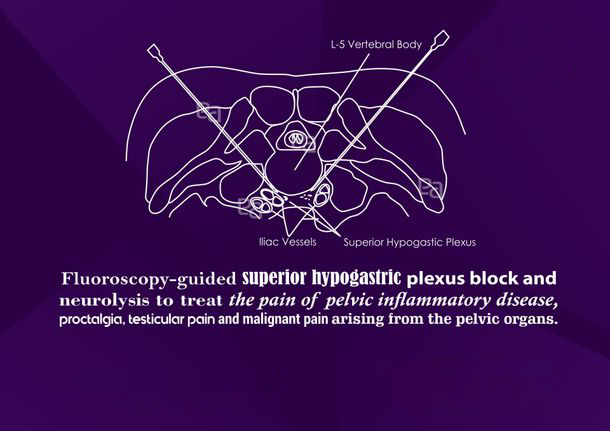

Treatments
ABDOMEN & PELVIC PAIN

Superior Hypogastric Plexus Block
What is a superior hypogastric plexus block?
The hypogastric plexus is a bundle of nerves near the bottom of your spinal cord. It could be blocked from carrying pain information from the pelvic region. The pain may come from the large intestines, bladder, uterus, ovaries, prostate, testicles, or other parts of the pelvis. The procedure also can help reduce pelvic pain from endometriosis, irritable bowel syndrome, radiation injury and cancer in the pelvis. There are many myths and misconceptions about cancer pain management, especially at the end-of-life, that it should be endured and is inevitable. These assumptions are not true.
How is a superior hypogastric plexus block done?
At Atlas Pain Care, you will be asked to lie on your tummy in the procedure room. Your back will be cleaned with antiseptic and draped with sterile dressing. Local anaesthetic is given to numb the skin before the start of the procedure. The doctor will then use an X-ray machine (fluoroscope) to guide the two procedure needles inserted in your back near the hip bone into the correct spot that gives access to the superior hypogastric nerve plexus. Contrast (dye) is injected to confirm correct placement, and medicines are injected to relieve pain. When the pelvic pain is due to cancer, alcohol or phenol is injected to provide permanent relief. The procedure takes about 30 minutes and you will be observed for an n hour after the procedure.
How effective is superior hypogastric plexus block?
Some patients report pain relief within 30 minutes after the injection, but pain may return a few hours later as the anesthetic wears off. Long-term relief usually begins in two to three days. How long the pain stays away is different for each patient. For some, the relief lasts weeks. For others, the relief lasts months. If the pain returns, the superior hypogastric plexus block could be done every few months.
What are the risks?
There are very few complications associated with this procedure. The most common include injection site pain and numbness in lower limbs. On the rare occasions, a slight headache may occur. Most of these effects will resolve within a few hours. Other risks like bleeding and infection are rare.
Please read our FAQ section to know more about the do's and don'ts prior to and after the procedure.

